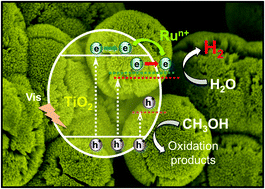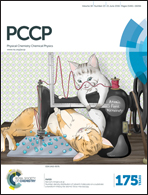Three-dimensional ruthenium-doped TiO2 sea urchins for enhanced visible-light-responsive H2 production†
Abstract
Three-dimensional (3D) monodispersed sea urchin-like Ru-doped rutile TiO2 hierarchical architectures composed of radially aligned, densely-packed TiO2 nanorods have been successfully synthesized via an acid-hydrothermal method at low temperature without the assistance of any structure-directing agent and post annealing treatment. The addition of a minuscule concentration of ruthenium dopants remarkably catalyzes the formation of the 3D urchin structure and drives the enhanced photocatalytic H2 production under visible light irradiation, not possible on undoped and bulk rutile TiO2. Increasing ruthenium doping dosage not only increases the surface area up to 166 m2 g−1 but also induces enhanced photoresponse in the regime of visible and near infrared light. The doping introduces defect impurity levels, i.e. oxygen vacancy and under-coordinated Ti3+, significantly below the conduction band of TiO2, and ruthenium species act as electron donors/acceptors that accelerate the photogenerated hole and electron transfer and efficiently suppress the rapid charge recombination, therefore improving the visible-light-driven activity.


 Please wait while we load your content...
Please wait while we load your content...